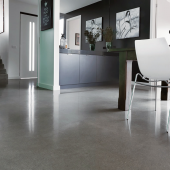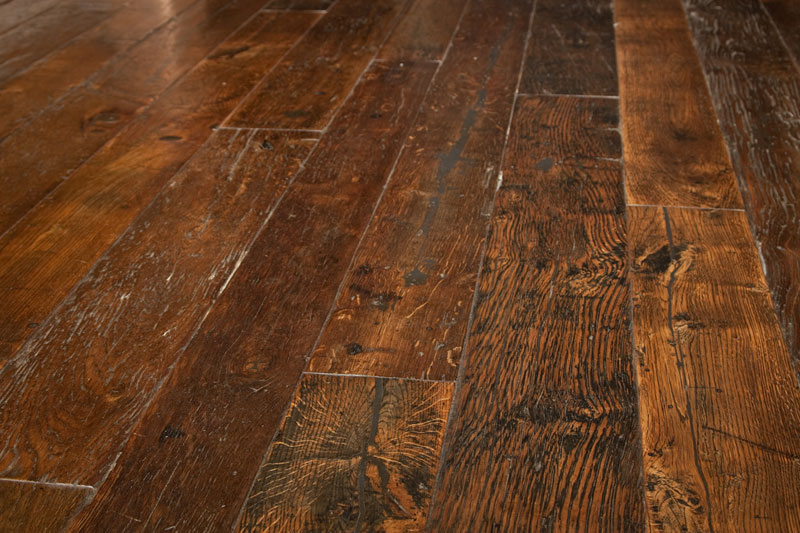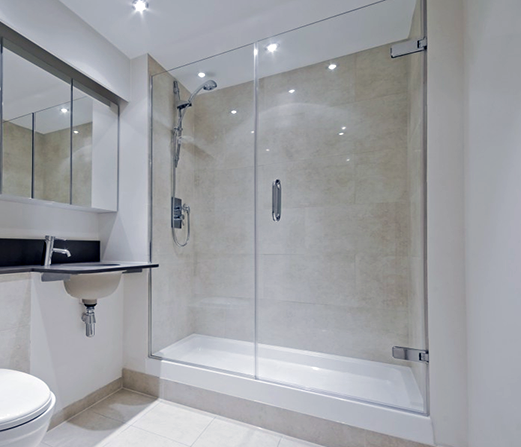Polished concrete is a decorative finish which is applied to a concrete surface, particularly an exposed concrete floor, through the addition of a densifier which is then followed by a grinding process to achieve the final result. It is a great and popular alternative to other kinds of flooring such as timber or tile, because it is quite cost effective, generally working with already existing slabs, as well as more resistant than other materials, providing an end result similar to that of polished granite or marble floors. It may be troublesome to achieve sometimes, but it is generally a gamble which tends to pay off in the long run.
There are two main ways to achieve a polished concrete floor: by applying the grinding process to a slab which has already been laid, or by adding a new slab. While the former is more sustainable, as it works with what already exists, it can be more expensive if the slab isn’t in good condition and it leaves you with less room for creativity, as the concrete which is already set is virtually impossible to modify or customize.
Laying a new slab, however, allows you to pick between colors, as well as finishes and decorative touches, such as grinding to show the stones beneath the slab, or adding your own materials before it dries. The final finish will depend on the slab and grinding grades, generally becoming shinier and smoother the finer the grinding used, which is applied progressively, is.
Polished concrete flooring has a number of benefits when compared to other flooring options. First of all, it is more cost effective than most, especially as it needs slightly less treatment and maintenance.
Aside from that obvious benefit, concrete offers many others, such as the ability to create a uniform, shiny look, which can easily transition between rooms and to the outside, ease for cleaning, as once sealed, it only needs to be wiped down weekly, and the ability to enhance light and warmth, thanks to its reflective features, which is excellent as it eliminates the need for extra lighting if the room benefits from a great deal of natural lighting already, and also for those who are planning on installing heated floors, as it conducts the heat nicely, thus enhancing the effect.
Also, polished concrete floors are long-lasting, not prone to cracking or breaking, and they are also more sanitary and appropriate for those who suffer from allergies, for whom carpeting, for instance, can be a nightmare to live with.
The fact that a non-slip coat can be added to polished concrete flooring only enhances its versatility, allowing it to be used both indoors and outdoors, for instance beside and in a swimming pool, as it is not prone to become slippery when it’s wet, making it safe for everyone to stand and walk on, even when exposed to the elements. The fact that it doesn’t stain easily or need a great deal of maintenance after being sealed is also a great advantage in this case, as outside flooring is exposed to the elements, and swimming pool maintenance is a great ordeal in itself that includes a number of chemical processes, which in turn could damage a material which is less resistant.
Aside from that, there are several other decorative options that can be taken when laying new slabs of concrete, such as mixing different aggregates’ – the stones and other materials used to make concrete – or staining, even stamping the concrete, to create unique patterns or make it look like other materials, such as marble and granite, creating the same look for a fraction of the cost, which can be quite an advantage when working on a tight budget. Stained and stamped concrete floors look particularly stunning in the outdoors, especially when creating a patio or lounging area, where the minimalist, lounge furniture really allows the flooring to take the center stage, which is something to take advantage of, as it is the key to achieving the atmosphere you are aiming for.
As for interior spaces, concrete flooring generally gives a very modern look to any room, which can be a useful feature when redoing an older house or building, as it instantly updates the look of the space. It also works quite nicely with a minimalist décor, as it complements the bare elegance of a room, adding to the effect due to its shiny, uniform simplicity, as well as the futuristic look of chrome kitchens, where the prospect of easy cleaning tends to be a major point in favor of concrete floors.
It is also worth noting that, thanks to its clean, sterile look, as well as easy maintenance and relative low cost, exposed concrete flooring is a very popular option for commercial buildings, such as malls, office buildings and even hospitals. Alas, since most of these buildings usually have a very modern, even impersonal atmosphere to them, exposed concrete floors tend to be a perfect choice, as they complement the general feel of the rooms perfectly.
Of course, for all its benefits, polished concrete does have its drawbacks as well. One of them is that it needs to be installed professionally, as the process of laying it down, adding the densifier and applying the correct grinding is quite a precise one, which takes time and skill to ensure a perfect result, as concrete is a tricky material to work with, and any misstep in the polishing process can end up ruining the whole slab.
Also, sealing is definitely necessary to avoid unwanted staining and preserve your new flooring as long as possible, as concrete isn’t naturally as resistant as stone, and it does need to be redone every couple of years to maintain the look and features of the floor, at the risk of losing its best properties if this small maintenance task isn’t performed in a timely manner.
Other drawbacks polished concrete flooring has are quite minor, such as easily showing imperfections like small cracks or naturally being a cold surface if not artificially heated, which may be deal breakers for some keen perfectionists, but should not sway your opinion unless you really are one of them, since the benefits which make polished concrete such a popular option at the moment largely outweigh them.















